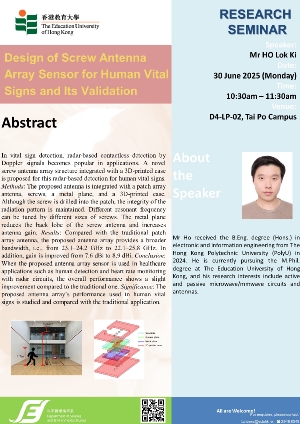

 |
You are cordially invited to participate in the Research Seminar by the Department of Science and Environmental Studies (SES).
In vital sign detection, radar-based contactless detection by Doppler signals becomes popular in applications. A novel screw antenna array structure integrated with a 3D-printed case is proposed for this radar-based detection for human vital signs. Methods: The proposed antenna is integrated with a patch array antenna, screws, a metal plane, and a 3D-printed case. Although the screw is drilled into the patch, the integrity of the radiation pattern is maintained. Different resonant frequency can be tuned by different sizes of screws. The metal plane reduces the back lobe of the screw antenna and increases antenna gain. Results: Compared with the traditional patch array antenna, the proposed antenna array provides a broader bandwidth, i.e., from 23.1–24.2 GHz to 22.1–25.8 GHz. In addition, gain is improved from 7.6 dBi to 8.9 dBi. Conclusion: When the proposed antenna array sensor is used in healthcare applications such as human detection and heart rate monitoring with radar circuits, the overall performance shows a slight improvement compared to the traditional one. Significance: The proposed antenna array’s performance used in human vital signs is studied and compared with the traditional application.
Details are as follows:
|
Date: |
30 June 2025 (Monday) |
|
Time: |
10:30 am – 11:30 am |
|
Venue: |
D4-LP-02, Tai Po Campus |
|
Topic: |
Design of Screw Antenna Array Sensor for Human Vital Signs and Its Validation |
|
Speaker: |
Mr Ho Lok Ki (SES MPhil student) |


|
30 Jun 2025 |

|
D4-LP-02, Tai Po Campus |




